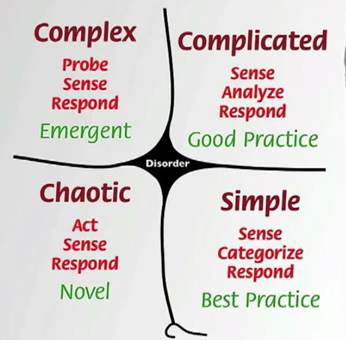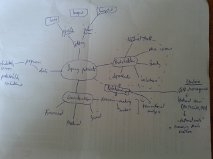Post in response to H817 MOOC activity 20: Rhizomatic Learning
Dave Cormier: http://www.youtube.com/watch?v=VJIWyiLyBpQ
Key features of Rhizomatic Learning
1. The best learning teaches you to deal with uncertainty
2. The community is the curriculum
3. Rhizomes offer a model for learning an uncertainty
4. Complex decision-making (probe, sense, respond)
5. Need to make students responsible for their own learning (and that of others)
Was I convinced by the approach?
The messiness and organic nature of the process was appealing – something I recognize from participating it the MOOC, and operating across a number of arenas in my Personal Learning Network (PLN).
What I like about the slidedeck (Cormier) is that is explicitly links types of learning to decision-making, which I feel is underplayed elsewhere in the field of learning. I see rhizomatic learning as useful, if not an ideal way of supporting learning that addresses ‘complex’ problems and decision-making (as shown in the matrix below).

This most accurately represents the working-learning environment for children’s centre leaders, that I came across in my MA research project, and rhizomatic learning is a good representation of the way in which those individuals responded to the environment – by making use of and extending their PLNs; exploring them with a specific, contextualized, learning agenda. Interesting, those most comfortable in their roles, articulated the existence of their own PLN (though not by that name) in their research responses, and their active pursuit of learning through it, whereas those less experienced individuals the learning through their PLNs seemed more incidental and unconscious.
Can this approach be implemented?
Accepting the above point, I can see the potential for supporting rhizomatic learning as a productive model where the context is supporting ‘complex’ decision-making, and not in environments which call for ‘complicated’ or ‘simple’ decision-making. I can, however, see that it might be potentially useful in environments of ‘chaotic’ decision-making, though there may need to be some re-working, perhaps a slimming down of linkages or arenas in the PLN to those most responsive (and trusted), so that they can be drawn upon within the time constraints that characterize chaotic decision-making.
Within the field I work in, complex family work (particularly when working with holistic, family-focused models, such as Family Intervention Projects), requires complex decision-making of the kind conceived in this model. Where in the past, there has been an emphasis on ‘complicated’ decision-making, where individual professionals with specific specialisms, such as mental health, substance misuse, domestic violence, not to mention the specialisms in either adult or children as individuals, the current trend is toward a more holistic and family-focused model with the need for trade-offs to be made between the value of certain interventions targeting different family members. Whereas the previous model required ‘experts’ to see through ‘good practice’ interventions, the new model requires unique and personalized support pathways to be constructed among groups of professionals from different specialisms, working collaboratively.
There has been some effort to introduce supporting infrastructure for this work (such as the Common Assessment Framework and Team around the Family meetings, to work across the children’s workforce for instance), but workforce development, notably, has not adopted a collaborative approach to knowledge and strategy construction. My instinct is that although examples of good practice exist, it has evolved organically.
How might a Rhizomatic approach differ?
Compared to a lot of commercial training on offer for the workforce I’ve described, the learning would need to utilize the existing relationships and networks that exist. Therefore, I think supporting Communities of Practice as groups, both directly and indirectly, is the way forward. Direct support would involve wrapping around a learning infrastructure to the existing work-based infrastructure of clusters and professional supervision. In addition, I think for many groups, a wayfinding and facilitating role would probably be needed to support the development of critical digital literacy skills and the socialization process. Indirect support would involve enabling access to or signposting relevant Open Educational Resources.
What issues would arise from implementing it?
Expectations. This is the biggest issue for me. When people purchase commercial training, there is often the expectation that they will get something defined for their money, and support is something they are used to having quantified (7 hours of directed study for instance). Equally, they are used to
having defined learning outcomes and success criteria, often supported by accreditation of some sort, and associated collateral such as a certificate. While it might be wise to produce some physical product to accompany the experience of participation, so as to meet an existing expectation, it remains the case that the absence of clearly measurable learning outcomes (related to the acquisition of subject knowledge) is a conceptual leap for some participants and some purchasers of training.
